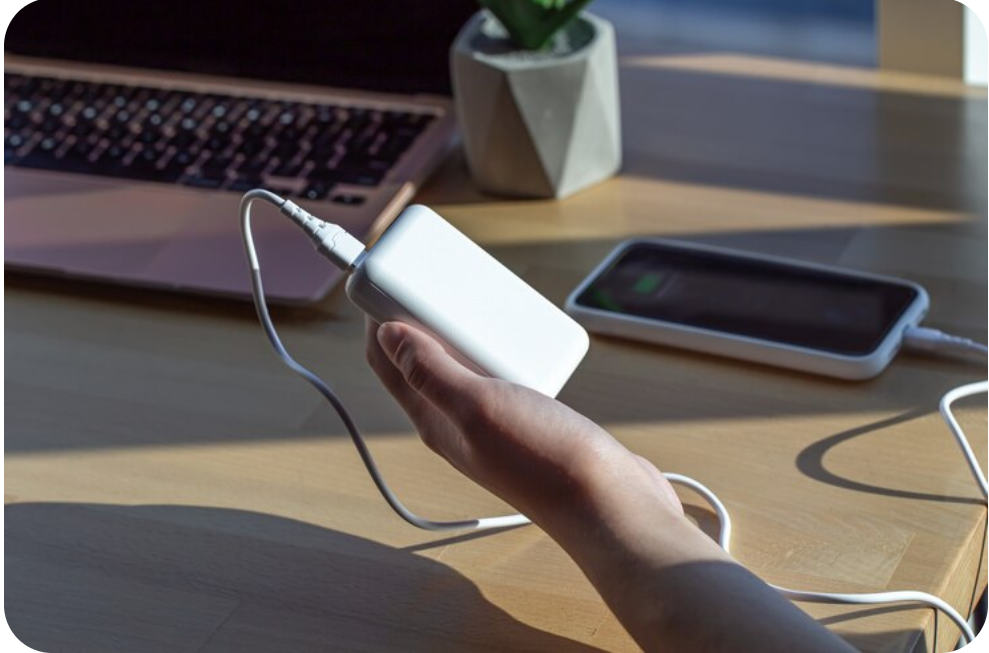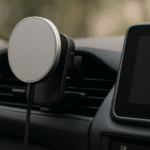Keeping a portable charger alive when there’s no wall outlet in sight may seem like a survivalist’s feat, but it’s a valuable skill for travelers, students on field trips, digital nomads, and anyone who has watched the battery icon inch toward zero during a blackout. In this article, I’ll explain how to charge a power bank without electricity from the grid, based on a decade of field testing and more than a few nights camping when a dead phone meant no maps, no flashlight, and no tunes. The solution is simple: provide you with clear, fact-based options that work, and provide the context you need to select the right one for your budget, climate, and habits.
When You Would Need to Charge a Power Bank Off‑Grid
Whether it’s power cuts, natural disasters, or various global pandemics, outlet space is always at a premium, if you can even find one that isn’t already being used by someone else. Your portable charger (a.k.a. a power bank, external battery or mobile power pack) is your life force, that is, only so long as you are able to give it some juice. Off‑grid recharging enables you to reach emergency services and run essential study apps, or to film, photograph, and navigate wherever you go. In the era of two-factor authentication and digital tickets, having power is no longer a luxury; it’s access.
The Science (in Plain English): Making Anything Into Useful Charge
It’s all doing the same thing: converting one form of energy — sunlight, movement, heat, or chemical potential — into direct current (DC) electricity that your portable charger can sip on through its USB or USB‑C port. What’s different is efficiency, speed, and convenience. Photons supply solar panels, your muscles drive hand cranks, temperature differentials energize thermoelectric modules, and car batteries tap stored chemical energy. That understanding of the chain will help you process claims and avoid gimmicks.
Method 1: Solar Recharging – The Easiest Off-The-Grid Solution
Sunlight, of course, is the most plentiful “free” power source, and commercial foldable solar panels now make the extraction process remarkably painless. I’ve charged 10,000 mAh banks under an afternoon’s worth of Karakoram sun, but I’ve also slogged through London winters so gray my panels barely trickled charge. Expect variability.
How to Pick A Solar Panel for Power Banks
The sweet spot, if you want to balance portability and power, is between 10 W – 28 W panels. A 5-watt panel will work technically, but you’ll wait hours. Also, panels with USBs or USB‑C PD (Power Delivery) on board obviate the need for external regulators. Monocrystalline cells tend to be more efficient than their polycrystalline counterparts, in low light conditions in particular. With weatherproof fabric casings and grommets, you can strap the panel to a backpack and charge as you hike — a classic thru-hiker move.
How to Use Solar Effectively
Tilt a panel up to a 90-degree angle to the sun, wipe off dust from the face, reconnect the cable if clouds cover for too long (some panels click off when voltage dips). If your portable charger is designed with pass‑through charging, you can recharge devices while the bank juices itself up, but note that this can stress cheaper cells. And midday, clear-sky irradiation is prime; winter mornings are not.
Method 2: Hand‑Crank and Kinetic Generators ‑ Power From Your Own Movement
When the sun goes down, or when you’re trapped inside unable to see it, next in line as a store of words follows your muscles. Hand crank generators or pedal dynamos convert rotary motion into electrical energy using a small alternator and a rectifier to convert electric current from AC to DC. They are light, tough, and fail‑safe because they’re driven by biology. The trade-off is output. And that means you have to crank and crank and crank for a long time to get any amount of capacity in the large portable charger. With the latter option, I’ve found even 5 minutes of heavy cranking only gives a few percent on a 5,000 mAh bank. For emergency SMS and mapping, however, that’s sufficient.
Making Kinetic Work For You
Secure the generator so you aren’t wrestling its wobble. You’re the control freak here, so get a hold of this or attach it to a table. Pump in logical chunks to keep it from getting too hot. A hub dynamo or portable roller generator, if you have a bike, can out-muscle hand cranks with long levers — your legs are the body’s largest muscles. Together with a 5V or 9V DC Power Regulator, you’ve got your own personal power plant.
Method 3: Thermoelectric Charging — Using Heat to Generate Watts
Thermoelectric generators (TEGs) work through the Seebeck effect: temperature differences across special materials cause a voltage. Camping stoves with integrated TEGs can produce sufficient current to drip‑charge a power bank while you boil water. They’re quiet and operate at night or in shade, but are expensive and tend to be slow. Consider them bonus power while you cook rather than your first line of attack.
Practical Tips With TEGs
Keep the flame constant and give the cold side of the module either airflow or let it touch cool water. Keep your USB cord from open flames. If your power bank has input wattage information, you’ll see it fluctuate; patience is built into this method.
Method 4: Sucking Power From Other Batteries — Phones, Laptops and Car Systems
Many current phones do support reverse charging – or USB‑C power sharing. If a friend’s phone is full, a little bit of a charge can be sucked back into your portable charger using a short USB‑C to USB‑C cable. Laptops and tablets can also accomplish this trick, but they die a lot faster than can be expected. There’s no waste of good energy in a car, where there’s almost always a 12-volt socket (previously known as the cigarette lighter). A good 12 V to USB adapter will allow you to top off almost as quickly as you do at home. A weak car battery, then charge while the engine is running to #34; save yourself from being stranded.
Safety First With Vehicle Sources
Never connect directly to a car battery unless you are completely aware of what you are doing and have a step‑down converter. Cheap power banks tend to fry up at the sudden voltage spike. Use only purpose-built adapters with a current rating that matches your needs.
Method 5:Wind and Water Micro-Turbines—Niche, but in the Right Place, Very Effective
It’s not common to see portable wind turbines and micro-hydro generators, but they do excel in certain niches. These machines can produce a universal slow drip at a windy basecamp or next to a fast stream. Set‑and‑forget generation is their superpower. They are unwieldy next to panels, and it can take all day to set them up, but they do the job when the sun is off-duty.
Stopgap Fixes to Avoid. Also, You Might Want to Think Twice Before …
At the other extreme, some online “hacks” suggest jamming a USB cable into random sockets, stacking lemons and driving nails between copper and zinc, or hot-wiring DC motors. These days, virtually all of those ideas yield just millivolts or erratic current that’s more likely to hurt your portable charger than help. Another dangerous hack is using unregulated dynamos without a buffer battery; voltage peaks can kick out your charger’s protection circuitry. Just stick to what works for you, or a cheap go-between power bank if you like playing to find out.
How to do it: My life Off‑Grid Recharging in practice
This is how I normally resurrect a portable charger on a multiday hike or city‑wide blackout. I begin by getting an estimate of remaining capacity: most banks today give you an LED or a digital readout. If I’m under 20%, I’ll lay down that solar panel as soon as I’m walking, wherever there’s sun. Short, fat cable from the bank to minimize high loss. I get up around lunchtime to check on progress; if there are clouds, I move back to a hand‑crank session while boiling water on a stove connected to a TEG panel (a sort of stacking source). Lake Windermere at dawn. And as darkness falls, I fill up from a friend’s laptop or a car socket where possible. If time behind the warm, dry bars is running low, I stuff the bank in a warm-n-spugly lockdown bag before bed so I don’t suffer a performance hit from frosty temperatures. This layering approach rarely fails.
Maintaining Your Portable Charger after an Off‑Grid Recharge
Lithium-ion and lithium-polymer cells do not like intense heat, overcharging, and being left discharged at 0%. Upon any unusual charging, check the bank: if it’s unusually hot, wait a while for it to cool down. Try to store at a 40% to 60% charge if you won’t be using it for weeks. To ensure the internal battery gauge is calibrated, run a full cycle once a month. Keep ports dry and clean of dust; even a little piece of grit can block a USB‑C connection and make you think your charger is dead.
Off-Grid Charging Speed, Cost and Effort Comparison
Solar is cost-effective to install and requires minimal effort, but is dependent on the weather. Hand‑crank and kinetic methods can work anywhere, but must be constantly labored over. Thermoelectric is situational, good if you’re already cooking, not so good if you’re not. Charging of vehicles and laptops is quick and easy yet requires a second charged source. Wind and water turbines supply an uninterrupted, unattended power; however, they are large and site‑specific. Think of your toolkit as a diversified portfolio: combine some quick wins (vehicle adapters) with some sustainable sources (solar) and some act-of-God scenarios (hand crank) to address all possibilities.
Mistakes That Cost Energy and Wreck the Gear
The most common mistake I see is with the use of a long, flimsy USB cable. Voltage lost to resistance through cheap wires squanders precious watts. Another error is either leaving a power bank attached to a weak or intermittent source or failing to confirm if the damn charging light is even on. People also overestimate panel ratings: a “21 W” panel will only output something like 21 W under lab-like conditions. And last: Do not stack the power banks in direct sunlight just because the panel is outside: Battery chemistry does not like heat.
SEO Corner: You Will Encounter These Semantic Terms Naturally
If you’re creating content around the top value keyword “portable charger,” occasionally include natural variations like power bank, USB‑C PD battery pack, off‑grid charging, solar phone charger, hand‑crank generator, thermoelectric stove charger, kinetic energy charger, emergency backup battery, mobile power station, reverse charging. Long‑tail phrases like how to charge a power bank without a wall outlet or best way to recharge a portable charger during a blackout attract intent‑rich visitors. The secret isn’t repetition, it’s relevance.
Final Thoughts
Charging a portable charger without an outlet isn’t magic; it’s preparation plus just a touch of physics. Whether you rely on the sun, your muscles, a campfire’s warmth, or the chemical stored in a car battery, you have choices. Cross-train methods, keep your gear in good working order, practice it before you need it so you’re not reading instructions by candlelight. Do the math, and the next time the lights go out, the most helpful gadget will be the one that’s still shining.
FAQs
How long does a solar panel take to charge a portable charger?
That will vary depending on what wattage panel you are using, how strong the sunlight is, and how big your bank is. A 20-watt panel on bright midday sun will be able to refill a 10,000mAh charger in four to six hours, but a 5-watt charger on a cloudy day could take up most of a day. Weather and cable quality matter about about one third as much as panel specs.
Can you use a hand‑crank generator on all chargers for mobile phones?
Typically yes, so long as the generator provides regulated 5 V or 9 V USB power. Some lower quality cranks will also produce some poor quality voltages…if you have a small cache battery or good voltage regulator, you protect your primary bank. Your arm will tire before most electronics will.
Is it safe to charge my portable charger with another phone?
Yes, as long as both products have USB‑C power sharing or reverse charging. Your donor phone will drain faster, transfer speeds are slow, but it is an emergency fix that is worth doing. Keep cords short & watch heat on both devices.
Do thermoelectric stoves actually work for charging?
They do, but slowly. Anticipate they will fill only slightly as you cook rather than fill-and-refill a larger bank. What they have going for them is that they’re not weather-dependent and are not at the mercy of sunlight — if you can make heat, you can make a little bit of electricity (and those few watts that a panel type can produce aren’t affected by the shadows of clouds).
What do I do if none of these are available?
Conserve power aggressively. Put your phone in airplane mode, turn down the screen brightness, close background apps, and use text instead of video calls. Sometimes the best way to ‘recharge’ is to stretch what charge you already have until an outlet shows up.
Is it true that charging off‑grid will shorten the lifespan of my portable charger?
Not inherently. What kills life is heat, overcharging, deep discharging, and bad voltage regulation. The good quality panels, adapters, and cables are safe. Just be sure to never needlessly push the battery to its limits.
Can I use a car 12V battery directly using a DIY cable?
You might be able to, but it’d be risky and is not advised unless you have a trusted step‑down converter, or a reliable 12 V to USB adapter. Failures can fry the charger’s input circuitry from incorrectly wired or spikes during engine start. When in doubt, shell out a few bucks on a certified adapter, rather than trying to MacGyver your own.
When my portable charger is charging, how can I see whether it is getting charged or not?
Many banks show a flashing LED or a battery symbol when receiving current. If your model has an LCD display, it might display input wattage or amperage. If nothing lights up, unplug and reseat, try a different cable, or make sure your source is supplying a minimum of 5 V.
How can I pre‑plan for outages so I never encounter this issue?
Some preparation helps: a 20–28 W foldable panel, a rugged hand crank, a car adapter, and quality cables fit in a shoebox. Before storms hit, always keep that portable charger topped up, and regularly rotate devices every month so nothing’s sittin’ and gittin’ unhealthy.














Leave a comment